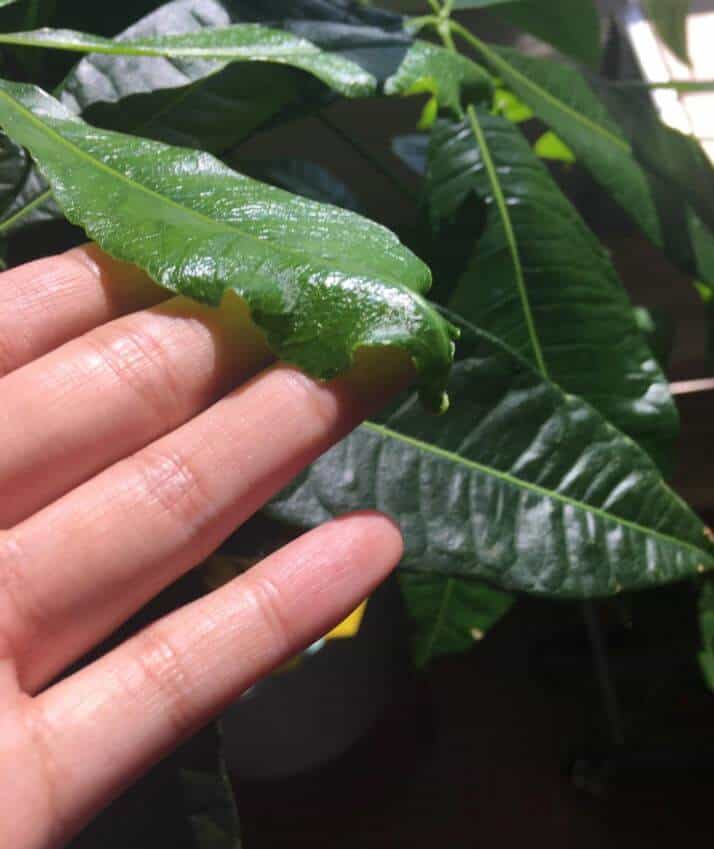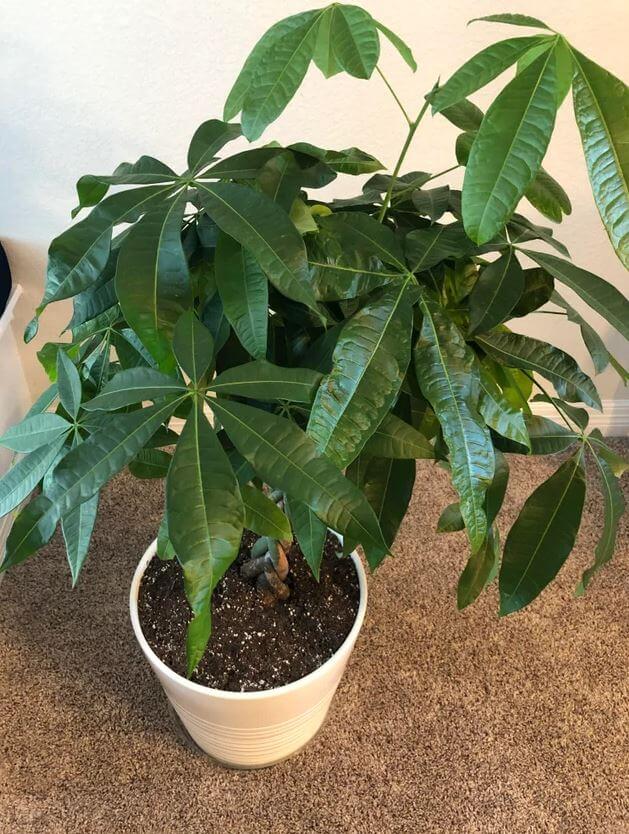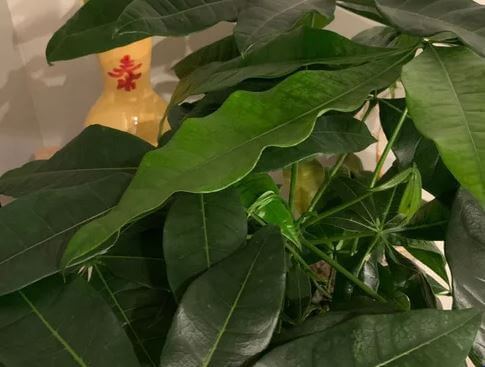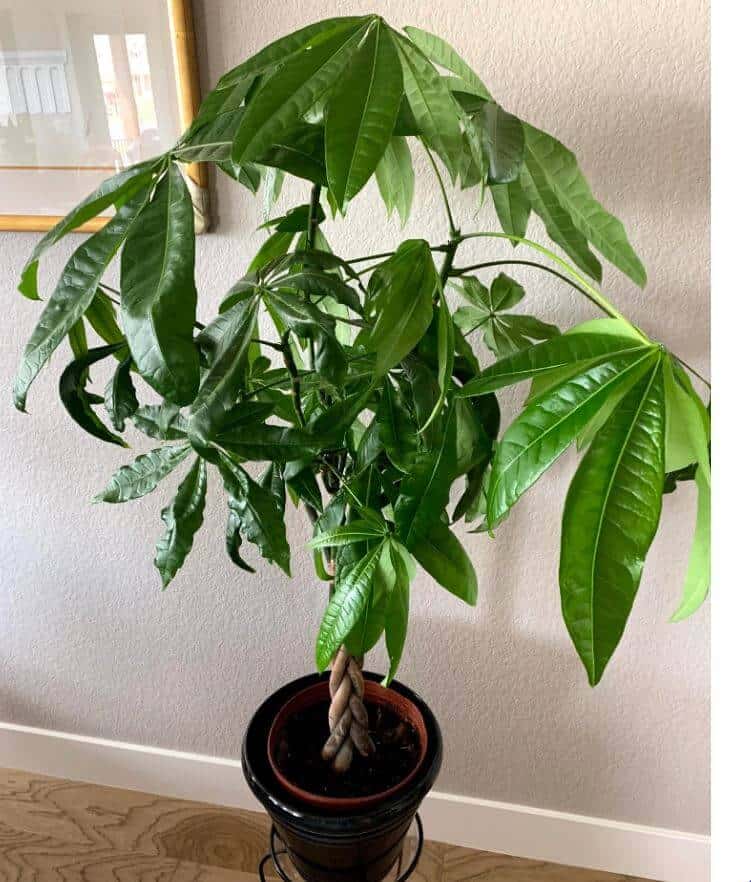Last Updated on June 4, 2023 by a Friendly Gardener
If your Money Tree has curling leaves, you may be worried that this spells a serious problem. A Money Tree will generally demonstrate that it is stressed by curling the tips of its leaves. Left unattended foliage will then wrinkle. What can you do about money tree curling leaves, and more importantly, what causes them?
All About the Money Tree

Botanically named the Pachira Aquatica, this plant is a tree that thrives in wetlands or swampy conditions. You may find it referred to as the Saba Nut tree, the provision Tree, the Malabar Chestnut, the Guiana Chestnut, or the French Peanut.
The Money Tree makes a wonderful houseplant, and you will generally find that it is sold with a braided trunk adding to its aesthetic appeal. Money trees are also thought to bring good luck to their owners.
Why Are My Money Tree Plant Leaves Curling?

There are various reasons that a Money tree may curl its leaves. These might include improper watering, incorrect humidity levels, the wrong environmental temperature, and more. While curling leaves may alarm you, the Money Tree is an easy-to-care-for plant. These curling leaves are generally symptomatic of a health issue. It may be a combination of growing conditions that contribute to Money Tree curled leaves and not a single plant health problem.
Here are several of the most common issues that can stress your Money Tree plant.
Water

Scientifically named the Pachira “Aquatica”, it stands to reason that this plant has a crucial relationship with water. Good hydration is essential to the plant’s general health, so both overwatering and underwatering can create serious problems.
· Overwatering
Overwatering is a cause of Money Tree leaves curling under or downward. This is an easy problem to resolve by simply reducing the amount of water or the frequency of watering. Limit your watering to when an inch of the plant’s topsoil is dry.
· Underwatering
Underwatering is also a cause of money tree leaves curling. Usually, however, leaves will curl upward when the plant is thirsty. Because your plant becomes dehydrated, leaves begin to curl upward and wrinkle. Correct your watering schedule to keep your plant sufficiently hydrated.
· Inconsistent Watering Schedule
If your watering schedule is a bit erratic, and you alternate between underwatering and overwatering, your plant will curl its leaves. If this continues for any period, foliage can appear to be sickly and may even look deformed. Adjust your watering schedule and make a point to maintain it.
Soil Conditions

Another reason for leaf curling is when the soil does not drain well, or the plant’s container does not provide adequate drainage. Although the Money Tree enjoys swampy locations, it cannot sit in waterlogged soil. Clay-based soil is ill-advised for these plants because it retains too much moisture potentially leading to root rot.
A quality potting soil mix that guarantees both drainage and aeration is the best choice. Your plant’s container should be appropriately sized for the plant and should have a certain number of drainage holes in the bottom. Pots should not be too large as they may have too much soil that retains excessive moisture for the size of the plant.
Light
Money Tree curling leaves can also be due to improper light exposure. This plant loves bright light, but it should be indirect. Direct exposure to sunlight can scorch leaves. If you have placed your plant in a low-light environment, foliage may curl in an outward direction. Place your plant in or near a window where sunlight exposure is indirect or where there is some filter like a sheer curtain.
Humidity Levels
If the tips of your Money Tree’s leaves curl, it can be due to a lack of sufficient humidity. Centralized heating or air conditioning as well as climatization units near the plant can cause leaves to curl. These units will lower indoor humidity levels. Leaf tips will curl.
To correct this, use a space humidifier near your plant or use a pebble tray. Grouping plants together can help create a microclimate with more humidity as can occasionally misting.
Environmental Temperature
Excessive heat can cause a Money Tree to curl its leaves as well as wilting. Your Money Tree prefers moderate room temperatures measuring between 55° and 65°F. The room where your plant is located should ideally maintain a constant temperature to ensure health.
Feeding

Like all plants, the money Tree will suffer if it has insufficient nutrition or is overfertilized. This can be avoided by diluting the 20-20-20 liquid fertilizer recommended dosage during the growing season. Avoid feeding a Money Tree during colder months when the plant will rest.
Pest Infestation
Pests can be a problem for any houseplant, and in the case of a Money Tree can be the cause of leaf curling. Pests that typically afflict a Money Tree include mealy bugs and aphids. These are sap-sucking insects that will suck the leaves of the Money Tree which will cause curling and deformity.
Other pests that can appear include spider mites, scales, whiteflies, and gnats. Pests not only will disturb the foliage but can attack the root system. If your Money Tree looks under the weather, check it and specifically the undersides of foliage for evidence of pests.
Mealybugs will leave cottony deposits while spider mites will leave webbing. Scale looks like a brown waxy substance on stems or leaves. You can attempt to remove some pests manually or with a water spray.
Afterward, you should treat your plant to eliminate the pests. Neem oil is a natural organic insecticide that does not harm people or pets, so it is a safe choice if you select to treat your plant. It also functions as a natural fungicide, so your plant will be protected from fungal infections and mildew.
All Things Considered

This delightful houseplant is very easy to care for, but like any houseplant, it can run afoul with improper growing conditions.
Money Tree leaves curling can be the result of one of these environmental conditions or a combination of several. If your plant’s leaves curl, check for all these problems and correct any conditions that might contribute to leaf curling.

